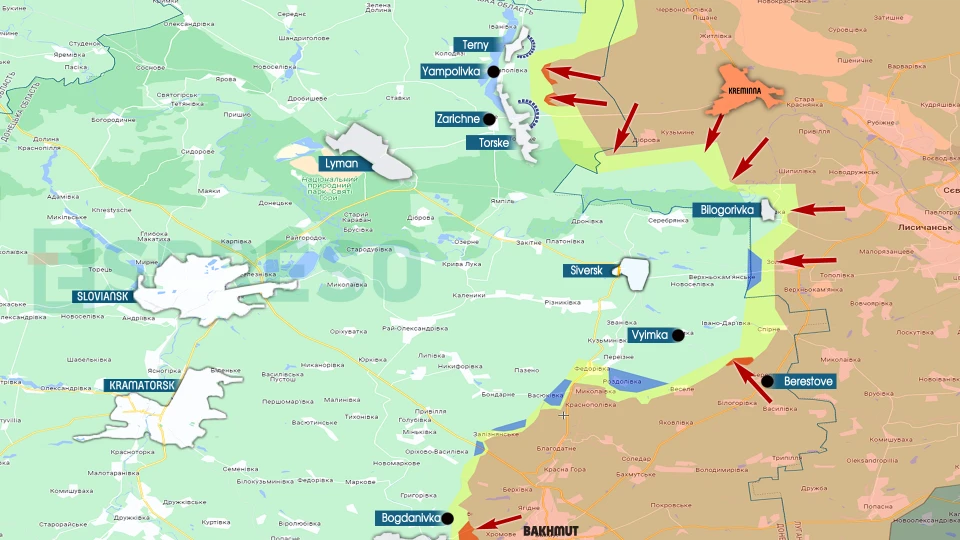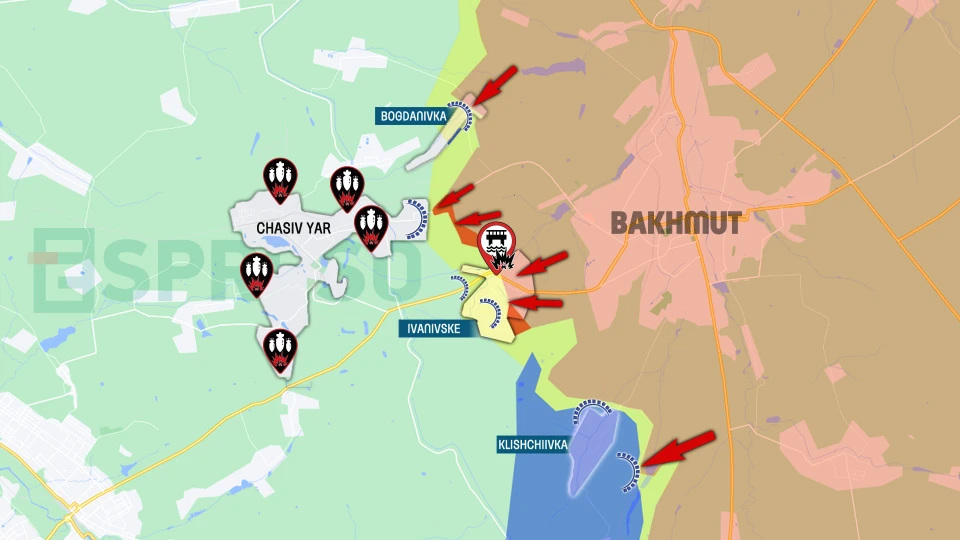
When Russia will intensify its offensive. Serhiy Zgurets’s column
Volodymyr Zelenskyy had previously addressed Russia's escalation of offensive actions, a sentiment reiterated by Kyrylo Budanov, the head of Defense Intelligence at the Ministry of Defense of Ukraine, in an interview with the German TV channel ARD
On Russia’s escalation of the offensive actions
Ukraine expects Russia to step up offensive actions in late spring - early summer. Volodymyr Zelenskyy spoke about this earlier, and now the head of the Defense Intelligence Kyrylo Budanov repeated it in an interview with the German TV channel ARD. Budanov assumes that the Russian troops will first of all try to advance near Donetsk in the direction of Chasiv Yar and further in the direction of the town of Pokrovsk. Simultaneously, he holds the belief that significant changes on the front line are unlikely prior to the anticipated Russian offensive. Presently, the head of Defense Intelligence assesses the situation in line with traditional military perspectives, indicating the challenges but asserting control. Surprisingly, Budanov entertains the possibility, even without ruling out, of a Ukrainian offensive within the year.
At the same time, this interview is more aimed at a Western audience and at Western politicians at a time when, on the front line, Russia seeks to take advantage of the window of opportunity, when the Ukrainian Armed Forces suffer from a lack of shells, artillery, and the actions are conducted by exhausted units that need replenishment.
I will repeat the important statement of the commander of the Ukrainian Ground Forces Oleksandr Pavlyuk, who called today to support the defenders in word and deed and to join the ranks of the Armed Forces. According to him, while the Ukrainian Armed Forces are fighting heroically and restraining the invaders along the entire front line, Russia is trying to shake our rear, sow enmity, panic, and mistrust of the army. Russia spends crazy resources on it. Pavlyuk called on Ukrainians to leave their emotions behind and not succumb to provocations. He said that we must realize that no one will be able to sit down, because the fate of the country, the fate of our nation is at stake. Russia will not let anyone rest. Pavlyuk believes that now is an extremely important historical moment that fate has given us - either we will protect and preserve the state, or we will disappear as a nation.
The frontline situation
Currently, Russia is trying to use its advantage in manpower and equipment. In addition to the active use of anti-tank missiles, which everyone knows about, it also began to actively use armored vehicles for assaults, when a tank or IFV with an armored landing party tries to quickly break through to our defense line. Another of Russia’s innovations is when its tanks and IFVs are getting equipped with the FPV drone system.
There was a notable incident near Terny where one of Ukrainian FPV drones successfully halted a Russian tank. This particular tank stood out due to its unique setup - the Russians had equipped it with at least 8 different types of EW on each sector and installed a generator. Despite these measures, the tank was finally disabled on the 4th attempt. Equally intriguing was the subsequent operation by our 12th Azov brigade, which managed to retrieve and secure the tank, a T-72 B3M version, within three days. It now stands as a trophy. The Ukrainian military is currently engaged in analyzing the new Russian EW system to gain insights into its functionality and capabilities.
There were a total of 66 combat clashes reported over the past day. Nearly half of these occurred in the western area of Bakhmut, including Bilohorivka, Bohdanivka, Ivanivske, and Chasiv Yar. Russian forces encountered resistance around Chasiv Yar, there were counterattacks. Recent intelligence indicated the movement of Russian reserves, and yesterday’s fighting was centered around Bohdanivka.

Denys Nahornyi, lieutenant colonel and chief of artillery staff of the Rubizh brigade, operating from the Bakhmut direction, noted a significant shift in Russian artillery tactics. He described the recent landscape as resembling the surface of the moon due to intensified bombardment. Russian forces have concentrated their artillery strikes primarily on Bohdanivka, the Kanal microdistrict, and the heights of Ivanivske and Klishchiivka. The strategic significance lies in the necessity for the Russians to secure access to key heights, particularly Chasiv Yar, which serves as a pivotal stronghold within the Donbas region.

Hence, despite facing fierce counter-battery fire, the Russians are bolstering their artillery deployment, seeking to leverage tactical aviation and bombers. Strikes from KAB munitions have targeted Chasiv Yar directly. Additionally, Russian forces have escalated their use of armored vehicles, each carrying 20-30 or more troops, aiming to position these units as close to the frontline as possible for assault operations. Ukrainian defense forces are actively countering such maneuvers. Thanks to our aerial reconnaissance, the rumble of approaching Russian columns is detected 2-5 kilometers away, allowing Ukrainian forces to significantly degrade them by 50-70% before they engage Ukrainian infantry in combat. Nevertheless, the sheer number of Russian forces remains overwhelming. Following the precedent set by Avdiivka, Russia has redirected its primary efforts in this direction. Despite the casualties incurred, it persists in its relentless pursuit of capturing Chasiv Yar at any cost.
The lieutenant colonel observed that Russia has initiated the modernization of Lancet drones into Scalpel drones. Consequently, it has become necessary to deploy 2-3 layers of anti-drone nets and adopt almost subterranean defensive measures. Thus, the nature of warfare has transitioned from trench warfare to underground warfare. This shift is driven by the proliferation of Lancet and Orlan UAVs in the airspace and Russia’s utilization of Krasnopol corrected artillery ammunition. For instance, there have been instances where Russia’s artillery shelling was followed by waves of several Lancets, succeeded by Krasnopol munitions guided by laser beams. This contrasts with Excalibur, a guided artillery projectile that relies on preset data for targeting. Dealing with Krasnopol presents a greater challenge, as if discovered, conventional digging-in is insufficient; guns must be concealed underground instead. It appears that Russia has adopted this tactic from our own playbook, likely due to the effectiveness of high-precision ammunition in neutralizing enemy artillery. The synergy between FPV drones and high-precision projectiles has enabled us to counter effectively what the Russians bring to the battlefield. However, the aggressor, still relying on outdated Soviet weaponry, possesses surplus munitions that continue to pose a threat.
The chief of artillery staff of the Rubizh brigade highlighted that the Russians have employed smoke screens by igniting tires to feign cannon hits, a tactic we have also adopted. However, achieving the desired effect requires a comprehensive approach, including engineering expertise, the deployment of nets, coordinated smoke screens, and an air defense system capable of neutralizing enemy detection capabilities in a timely manner to blind adversaries. By limiting their visibility, enemies are less able to accurately target our positions, rendering this tactic highly effective. This underscores a fundamental aspect of contemporary warfare: increased visibility equates to greater understanding of enemy movements and intentions.
The officer further noted that a significant portion of Russia's infantry is concealed underground, posing a considerable challenge in detecting their movements. Therefore, it is crucial to anticipate their approach in advance to prevent their accumulation. Russian troops demonstrate adeptness in digging underground structures. For instance, upon discovery of one Russian dugout, an entire underground complex resembling a town was unearthed. Nonetheless, our troops exhibit remarkable skill in uncovering such enemy strongholds.
Summarizing Denys Nahornyi, I will note that Ukrainian defenders use all technological solutions and approaches to effectively destroy the enemy. We have everything, but we need more ammunition. I think that this is the main challenge facing our Armed Forces in order to repulse the enemy both in the Bakhmut direction and near the Chasiv Yar and in other areas of the front where the invaders are trying to push through our defenses. If the help from our partners is timely and powerful, then the losses of the occupiers will be colossal, facilitating our current wartime objective of exhausting the enemy forces.
- News












































